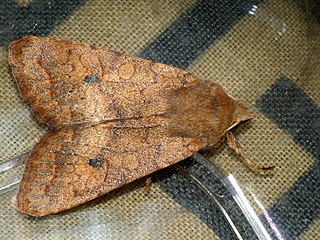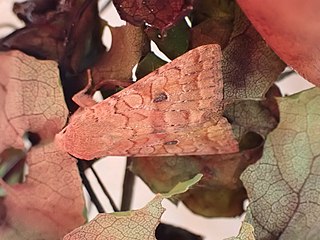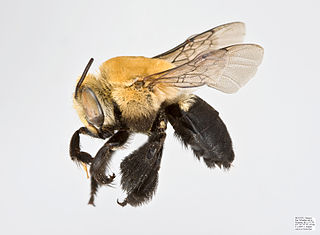
Agrochola circellaris, or The Brick, is a species of moth of the family Noctuidae. The species was first described by Johann Siegfried Hufnagel in 1766. It is distributed throughout most of Europe, Asia Minor and Armenia.

Agrochola lota, the red-line Quaker, is a moth of the family Noctuidae. The species was first described by Carl Alexander Clerck in 1759. It is distributed throughout the whole of Europe except Scandinavia; in Armenia, Asia Minor, and east across the Palearctic to the Altai mountains and western Siberia.It was introduced to Newfoundland. In the Alps, it rises at altitudes of just over 1500 metres.

Agrochola lychnidis, the beaded chestnut, is a moth of the family Noctuidae. The species was first described by Michael Denis and Ignaz Schiffermüller in 1775. It is distributed throughout the whole of Europe from Ireland to the Urals. It also occurs in western North Africa and Asia Minor.

Agrochola macilenta, the yellow-line Quaker, is a moth of the family Noctuidae. The species was first described by Jacob Hübner in 1809. It is found in Europe and in Asia Minor.

Agrochola is a genus of moths of the family Noctuidae. The genus was erected by Jacob Hübner in 1821.

Agrochola verberata is a moth in the family Noctuidae first described by Smith in 1904. It is found in western North America, from south-central Saskatchewan west to Alaska and coastal British Columbia, south to at least south-western Montana and south-western Colorado.

Agrochola litura, the brown-spot pinion, is a moth of the family Noctuidae. The species was first described by Carl Linnaeus in 1761. It is found in Europe and the Middle East. It is possibly also present in North Africa, but this is unclear because similar looking species Agrochola meridionalis is found there.

Agrochola laevis is a moth of the family Noctuidae. It was described by Jacob Hübner in 1803. It has a disjunct distribution in southern and central Europe, the Near East, Asia Minor and Armenia. The habitat consists of warm deciduous forests.

Agrochola humilis is a moth of the family Noctuidae. It is found in parts of Central- and Southern-Europe and Asia Minor.

The wych elm cultivar Ulmus glabra 'Nitida' [:'shining', an allusion to the smooth upper surface of the leaves], the smooth glossy-leaved wych, was described by Fries from specimens collected by P. C. Afzelius in 1841 on the island of Stora Karlsö, Sweden, as Ulmus montana nitida, in Novitiae Florae Suecicae: continuatio, sistens Mantissam III: 20 (1842). The Novitiae Florae Gotlandicae (1844) confirmed U. montana f. nitidaFr. as present on the islands of Stora Karlsö and neighbouring Lilla Karlsö off Gotland, Sweden, but did not report it from Gotland proper. A Stora Karlsö specimen from the Herbarium E. Fries is preserved in the Botanical Museum of Uppsala. The tree was listed by Rehder as U. glabraHuds. f. nitida (1915), a designation adopted by Krüssmann (1984), the latter copying Rehder's 'Norway' provenance error.

Rhyssella nitida is a species of ichneumon wasp in the family Ichneumonidae.

Centris nitida is a species of centridine bee in the family Apidae. It is found in Central America.
Perlesta nitida, the tiny stone, is a species of common stonefly in the family Perlidae. It is found in North America.

Orthonevra nitida , the Wavy Mucksucker, is a fairly common species of syrphid fly. It has been observed in Eastern and Central North America. Hoverflies get their names from the ability to remain nearly motionless while in flight. The adults are also known as flower flies for they are commonly found around and on flowers from which they get both energy-giving nectar and protein rich pollen. Larvae for this genus are of the rat-tailed type. O. nitida larvae have not been described.
Eudioctria nitida is a species of robber flies in the family Asilidae.
Phyllophaga nitida is a species of scarab beetle in the family Scarabaeidae. It is found in North America.
Plateumaris nitida is a species of aquatic leaf beetle in the family Chrysomelidae. It is found in North America.
Cyrtophleba nitida is a species of bristle fly in the family Tachinidae. It is found in North America.

Pyrenula nitida is a species of crustose lichen belonging to the family Pyrenulaceae.















